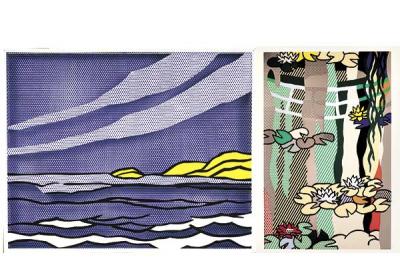Lichtenstein Land and Seascapes

The more than 30 works assembled for “Roy Lichtenstein: Between Sea and Sky,” which will open Sunday at Guild Hall and remain on view through Oct. 12, provide a master class in the artist’s use of an encyclopedic range of materials and processes, many of them industrial, to revive the landscape genre, expand its possibilities, and mine its art historical antecedents.
By 1964, Lichtenstein’s Pop style had evolved into the polished appearance that, in the artist’s words, “hide the record of my hand.” That same year he created his first cartoon-style land and seascapes and exhibited them at the Leo Castelli Gallery in Manhattan.
While some of the early landscapes used oil and Magna on canvas, several, including “Seashore” (1964), were done on Plexiglas by drawing the image on the adhesive protective backing, then using a razor blade to cut and peel away the outlines before repainting over them in black. Dotted areas were removed and repainted next, followed by the colored forms.
He also discovered Rowlux, a polycarbonate sheet consisting of microscopic spherical lenses that created oscillating three-dimensional patterns. Combined with other plastics, such as Mylar, he “perfectly channeled America’s enthrallment with the space age and fit squarely in with the rest of the Pop/Op aesthetic sweeping the country,” according to a catalog essay by Clare Bell of the Roy Lichtenstein Foundation, which collaborated with Guild Hall on the exhibition.
Over the next three decades, Lichtenstein’s landscapes were realized in porcelain enamel on steel, felt, lithography, ink drawing, a film installation, and a billboard, to name just a few. He attached motors to some of the early seascapes to generate the rocking motions of waves, and incorporated lightºbulbs and gels to simulate the change from day to night.
The land and seascapes utilize his signature motifs as well, including the Benday dots familiar from newspapers and comic books and, in the 1980s, a series in which entire seascapes were composed of Pop brushstrokes, which had stood alone as the subject of some of his early works.
Throughout his career, Lichtenstein drew on the entire corpus of art history. For example, in a series from the 1990s called “Landscapes in the Chinese Style,” he used gradations of Benday dots, without any outlines, to recreate the gentle atmosphere of mountains, treetops, and fog in works appropriated from the Song dynasty. Another series, also from the 1990s, brought the Benday dots, sharp diagonals, bright colors, and irregularly shaped, flat areas of solid color to bear on Monet’s “Water Lilies.”
According to Ms. Bell, “In 1970, Lichtenstein left New York City for Southampton, New York. By then, plastics played a more minor role in his production, but his land and seascapes remained an integral part of his explorations into the nature of illusionism, abstraction, serialization, stylization, and appropriation until his death in 1997.”
Thomas Crow, professor of modern art at the Institute of Fine Arts, New York University, will deliver a free keynote lecture on Lichtenstein on Saturday from 3 to 4 p.m., after which an opening reception will be held. Other public programs will include a gallery talk by Clare Bell on Aug. 30 and two panel discussions.
The Lichtenstein exhibition is the centerpiece of Guild Hall’s summer benefit, which will begin tomorrow with a preview and cocktails from 5 to 7 p.m. and be followed by drinks, dinner, dancing, and a live art auction at a private home in East Hampton. Tickets are $500 for the preview and cocktails, $1,200 and up for the entire event. Reduced prices are available for patrons 21 to 40 years old.
